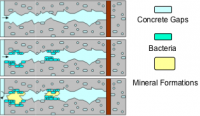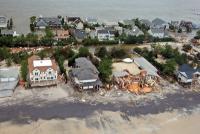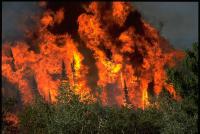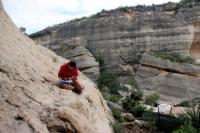-
Self-healing concrete being tested

At present, billions of pounds are spent every year maintaining, fixing, and restoring structures such as bridges, buildings, tunnels, and roads. It is estimated that around £40 billion a year is spent in the United Kingdom on the repair and maintenance of structures, the majority of which are made from concrete. Researchers are testing three separate concrete-healing technologies for the first time in real-world settings, with a view to incorporating them into a single system that could be used to automatically repair concrete in the built environment.
-
-
Update issued for southeast Florida regional sea level rise projections
The four-county Southeast Florida Regional Climate Change Compact (Compact) has prepared an update to the regional sea level rise projections used for important planning purposes. Overall, the update includes minor changes to the short-term curves, but a more significant increase in the mid-and long-term projections. The 2015 update estimates sea level rise of 6 to 10 inches by 2030, or 3 to 5 inches above average sea level in 2015. Predictions for the mid-term are between 11 and 22 inches of additional sea level rise by 2060, and longer-term between 28 and 57 inches by 2100.
-
-
New York proposes new sea-level rise projection regulations
New York State Department of Environmental Conservation (DEC) announced last week that to better prepare New York State coastal communities and business owners for extreme weather events like Superstorm Sandy three years ago, DEC is proposing new state sea-level rise projections which will help state agencies and project planners develop more resilient structures. “The sea-level rise projections DEC is proposing today reflect the best science available,” said DEC acting commissioner. “Sea level projections will help state agencies, developers, planners and engineers to reduce risks posed by rising seas and coastal storms over the next several decades.”
-
-
NSF highlights more than forty years of supporting cybersecurity research and education

New report highlights NSF-funded cybersecurity research and education. Today, NSF invests nearly $160 million each year in interdisciplinary research, education, and workforce development help protect national and personal security. This support helps scientists develop the tools, training, and people that will keep the nation safe and maintain online privacy.
-
-
In our Wi-Fi world, the internet still depends on undersea cables
Not many people realize that undersea cables transport nearly 100 percent of transoceanic data traffic. These lines are laid on the very bottom of the ocean floor. They’re about as thick as a garden hose and carry the world’s Internet, phone calls and even TV transmissions between continents at the speed of light. A single cable can carry tens of terabits of information per second. The cables we all rely on to send everything from e-mail to banking information across the seas remain largely unregulated and undefended. Any single cable line has been and will continue to be susceptible to disruption. And the only way around this is to build a more diverse system, because the thing that protects global information traffic is the fact that there’s some redundancy built into the system. But as things are, even though individual companies each look out for their own network, there is no economic incentive or supervisory body to ensure the global system as a whole is resilient. If there’s a vulnerability to worry about, this is it.
-
-
California releases plan for preparing the state for extreme effects of climate change

In response to a directive from California governor Edmund G. Brown Jr., the California Natural Resources Agency has been seeking public comment on a draft plan for how California will prepare for and adapt to the catastrophic effects of climate change, including extended droughts and wildfires, rising sea levels and increasingly extreme weather. The draft plan — Safeguarding California: Implementation Action Plans — identifies the state’s vulnerabilities to climate change and details steps that need to be taken across ten sectors including water, transportation, agriculture, biodiversity and habitat, emergency management, and energy.
-
-
Wildfires may double erosion across a quarter of western U.S. watersheds by 2050

Wildfires, which are on the rise throughout the west as a result of prolonged drought and climate change, can alter soil properties and make it more vulnerable to erosion. A new study shows that the increase in wildfires may double soil erosion in some western United States by 2050, and all that dirt ends up in streams, clogging creeks and degrading water quality.
-
-
Bikini islanders petition to relocate to U.S. as rising seas threaten to swallow their island

About 1,000 Bikini islanders have petitioned to be relocated to the United States as rising seas threaten to swallow their adopted home. Several hundred islanders were moved from their homes on the Bikini Atoll in 1946 when the United States decided to use it for nuclear weapons tests. In 1948 the islanders were settled on a nearby island in the Marshall chain called Kili. In the last decade, however, climate change and sea level rise have made life on Kili dangerous, as the island has been steadily losing the struggling against huge tides and increasingly ferocious storms.
-
-
Extreme weather events in Chesapeake Bay offer clues for future

For the millions of people who live in its expansive coastal areas, Chesapeake Bay provides an important source of income and recreational enjoyment. To protect the ecosystem and the livelihood of area residents, it is important to assess how climate variability and change will affect Chesapeake Bay’s shallow water ecosystems and water quality.
-
-
Analyzing bedrock could help builders, planners identify safe building zones

Research could give builders and urban planners more detailed information about how susceptible areas are to landslides and earthquakes. The researchers focused on bedrock, just beneath the soil and roots and the Earth’s surface. Bedrock is the layer at the bottom of what geologists refer to as the “critical zone” because its cracks and fractures provide pathways for air and water, which break down rock and form the soil that is an essential ingredient for all living organisms.
-
-
Inspired by cats’ eyes, new camera can look inside nuclear reactors

Currently 11 percent of electricity worldwide is generated by nuclear reactors. There are 435 reactors in operation with another 71 under construction. Engineers, drawing inspiration from the eyes of cats, have created a new camera that can see radiation coming from nuclear reactors — boosting safety, efficiency, and helping during nuclear disaster emergencies.
-
-
PNNL to help DHS address critical infrastructure vulnerabilities
The Department of Energy’s Pacific Northwest National Laboratory (PNNL) has been named a supporting laboratory to the National Infrastructure Simulation and Analysis Center (NISAC). NISAC is a Department of Homeland Security (DHS) program which addresses the potential vulnerabilities and consequences of disruption of U.S. critical infrastructure. PNNL says it will contribute advanced computer modeling and simulation capabilities to look at the dependencies, interdependencies, vulnerabilities, and complexities of important critical infrastructure sectors such as dams, water, transportation, energy, and information technology.
-
-
Concrete innovation makes Seattle skyscraper stable
All coupling beams in the 1.5 million-square-foot Lincoln Square Expansion — which includes luxury condos, a hotel, dining, retail and office space in two 450-foot towers in the heart of Seattle suburb Bellevue, Washington — are made of fiber-reinforced concrete using a unique design. These concrete coupling beams span doorways and windows, helping walls with such openings in them to function as a single structural unit, while bolstering the building as a whole against earthquakes. Traditionally, coupling beams are reinforced with a labyrinth of rebar, adding a great deal of time, cost and complexity to the construction process.
-
-
Tsunami-prone nations should follow Japan’s new approach to coastal defenses
Japan’s lead in implementing sea defense improvements to guard against future disasters is an important reference point for other tsunami-prone nations. In the wake of the March 2011 Fukushima disaster, Japan has drawn new engineering guidelines which have transformed Japan’s coastal defenses, and has devised new ways to keep its coastlines safe in the future. Other nations in known tsunami risk areas, however, have not yet followed suit.
-
-
Bad governance is a threat to freshwater supply
Scientists have analyzed nineteen different characteristics critical to water supply management in 119 low per capita income countries and found that vulnerability is pervasive and commonly arises from relatively weak institutional controls. The study sought to identify freshwater supply vulnerabilities using four broad categories: endowment (availability of source water), demand, infrastructure, and institutions (for example, government regulations).
-
More headlines
The long view
Helping Strengthen America’s Critical Infrastructure
Everyday life depends on a robust infrastructure network that provides access to running water, communications technology and electricity, among other basic necessities. The experts who keep our national infrastructure secure and resilient also need a strong network to share their knowledge and train the next generation of professionals capable of solving complex infrastructure challenges.
AI and the Future of the U.S. Electric Grid
Despite its age, the U.S. electric grid remains one of the great workhorses of modern life. Whether it can maintain that performance over the next few years may determine how well the U.S. competes in an AI-driven world.
Using Liquid Air for Grid-Scale Energy Storage
New research finds liquid air energy storage could be the lowest-cost option for ensuring a continuous power supply on a future grid dominated by carbon-free but intermittent sources of electricity.
Enhanced Geothermal Systems: A Promising Source of Round-the-Clock Energy
With its capacity to provide 24/7 power, many are warming up to the prospect of geothermal energy. Scientists are currently working to advance human-made reservoirs in Earth’s deep subsurface to stimulate the activity that exists within natural geothermal systems.
Experts Discuss Geothermal Potential
Geothermal energy harnesses the heat from within Earth—the term comes from the Greek words geo (earth) and therme (heat). It is an energy source that has the potential to power all our energy needs for billions of years.
